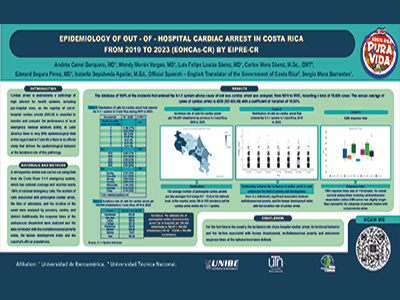ABSTRACTS
Epidemiology of Out-of-Hospital Cardiac Arrest in Costa Rica from 2019 to 2023 (EOHCAs-CR) by EIPRE-CRAuthor: Andres Cairol, Wendy Morun, Luis Felipe Loaiza, Carlos Mora, Edward Segura, Isabella Sepúlveda, and Sergio Mora | | Associate Authors:
Introduction: Cardiac arrest is undoubtedly a pathology of high interest for health systems, including prehospital ones, so the registry of out-of-hospital cardiac arrests (OHCA) is essential to monitor and compare the performance of local emergency medical services (EMS). In Latin America, very little epidemiological data is available in this regard, and in Costa Rica no official study has defined the epidemiological behavior or the incidence of this pathology. Objective: To determine the epidemiology of OHCA in Costa Rica from 2019 to 2023. Materials: A retrospective review was carried out using data from the Costa Rican 9-1-1 emergency system, which has national coverage and receives almost 100% of national emergency calls. The number of calls associated with OHCA, time of admission, and location of the event were analyzed by province, canton, and district. Additionally, ambulance response times were analyzed and correlated with the Multidimensional Poverty Index (MPI), the Human Development Index (HDI), and the country's official population numbers. Results: The national rate of OHCA is 382.24 per 100,000 inhabitants (335.62–432.09 per 100,000 inhabitants). The average number of OHCAs per day averages 10.9 (8.7–13.2) nationwide. A call for cardiac arrest goes into the 9-1-1 system every 106 to 183 minutes. A statistically significant association exists between both MPI and HDI and the incidence of cardiac arrest. Nationwide, the response time to a cardiac arrest is 15.54 minutes (SD = 11.82). The average response time of the Greater Metropolitan Area (GAM) provinces is 13.78 minutes (SD = 1.96) versus 18.59 minutes (SD = 1.28) for non-GAM provinces. This is a statistically significant difference (df = 5, t = 7.8, p = .00026). Conclusion: For the first time, the incidence of OHCA across Costa Rica was identified and related to factors associated with human development and multidimensional poverty. Ambulance response times at the national level were also identified. A statistically significant difference in response time was found between GAM provinces and non-GAM provinces.
|

